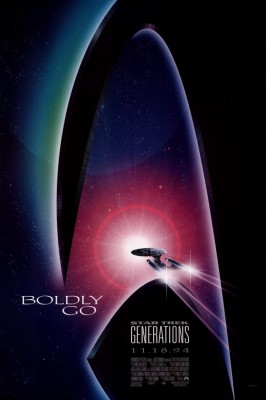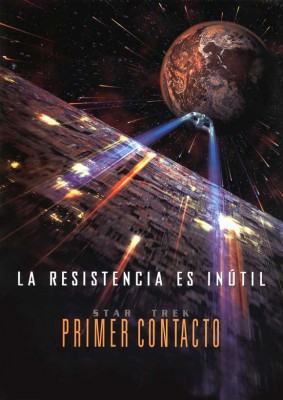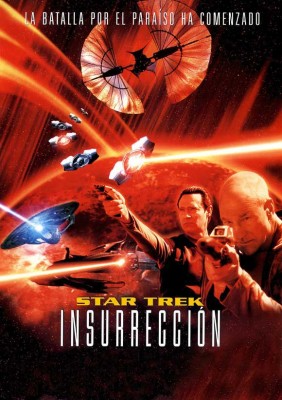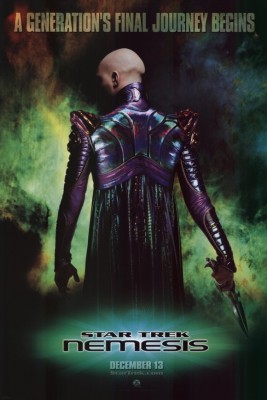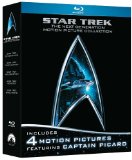| Reviews & Columns |
|
Reviews DVD TV on DVD Blu-ray 4K UHD International DVDs In Theaters Reviews by Studio Video Games Features Collector Series DVDs Easter Egg Database Interviews DVD Talk Radio Feature Articles Columns Anime Talk DVD Savant Horror DVDs The M.O.D. Squad Art House HD Talk Silent DVD
|
DVD Talk Forum |
|
|
| Resources |
|
DVD Price Search Customer Service #'s RCE Info Links |
|
Columns
|
|
|
Star Trek: The Next Generation Motion Picture Collection (Generations / First Contact / Insurrection / Nemesis)
By the early-1990s, the Star Trek franchise had firmly reestablished itself with six generally entertaining and commercially successful movies starring the aging but beloved original cast from the '60s TV show. Further, Star Trek: The Next Generation, which debuted between the releases of Star Treks IV and V, proved enormously popular in first-run syndication, signaling the gradual shift by the television industry away from primetime network programming. Audiences barely had time to miss the characters when Star Trek Generations premiered: the last episode of The Next Generation had aired only six months before. But the timing seemed right, all the stars were in alignment. It was a chance to transition away from the original cast, whose last film opened in 1991, and three of that series' stars - James Doohan (Scotty), Walter Koenig (Chekov), and William Shatner (Captain Kirk) - agreed to appear in the film to symbolically pass the baton.
Actually, they almost literally pass the baton because as the film opens, the three old-timers - in reality, Shatner was 63, Doohan was 74, and Koenig was 58 - are brought aboard the latest USS Enterprise as guests for its ceremonial maiden voyage. But what was intended as a media event becomes a crisis when the ship encounters a colossal ribbon of energy. Dr. Tolian Soran (Malcolm McDowell) and Guinan (an uncredited Whoppi Goldberg) are among those rescued from a nearby ship, but when the Enterprise herself becomes trapped Kirk is apparently killed when a portion of the Enterprise is ripped wide open.
Nearly 80 years later, a virtually unchanged Soran is rescued by the Next Generation crew from a solar observatory where the scientist is secretly working with Klingon rebels to create some kind of advanced weapon, though Soran's true motives involve physically returning himself to the energy ribbon. Guinan later explains to the Enterprise's current captain, Jean-Luc Picard (Patrick Stewart), that those swept up in what she calls The Nexus, an alternate dimensional world she describes as "like being inside joy," become addicted to the emotional high and never want to leave.
What's odd about Star Trek Generations is how it makes virtually no effort to introduce its established TV characters and situations to a mainstream audience unfamiliar with the Next Generation's universe. Indeed, there are numerous, arguably endless references to past episodes even casual fans were likely to miss. For the most part it plays like a spruced up two-parter of the TV series rather than a big-scale feature film, something the "original cast" movies generally avoided, despite their comparatively modest budgets. Meanwhile, the awkward insertion of Kirk, Scotty, and Chekov into the story makes the already herky-jerky script seem even more episodic and uneven.
The result is that Generations and the three sequels that followed, to a greater or lesser degree, were made for hardcore (and casual) Star Trek fans rather than mainstream moviegoers - i.e., non-fans - and didn't have much luck expanding the franchise's audience, although the second film was more successful in this regard. In Generations' case the filmmakers erred in not breaking away from the series more, and not trying harder to ease non-Trekkers into its universe.
(Spoilers) Another mistake, though it must have seemed like a good idea at the time, was in hedging their bets coaxing a few original cast members into the film. DeForest Kelley (Bones) had retired and was in poor health, while Nimoy declined to participate, leaving Doohan and Koenig to read dialogue intended for Nimoy and Kelley, coming off like second stringers pinch-hitting for MIA stars. Shatner's role in the film seems to have been directly inspired by Charlton Heston's extended cameo in Beneath the Planet of the Apes (1970). In both cases the bigger star appears in the opening scenes only to vanish into a strange void but who reappears for the climax, sharing scenes with the younger, more prominent lead, only to die at the end. (Captain Kirk's death in the film was widely known prior to the film's release.)
Shatner's fun to watch, especially his interaction with Stewart, but he has so little screentime one is left feeling he either should have been in the film start-to-finish or not at all.
Another problem with all the Star Trek movies, this more than most, is that the writers/producers feel compelled, partly due to fan pressure - to highlight each regular cast member in a scene or two, and the tendency - from the first Star Trek movie in 1979 but especially after the huge success of the lighthearted Star Trek IV: The Voyage Home - to infuse these scenes with an abundance of comedy. Star Trek Generations has a terminal case of the cutes and the story is spread too thinly among too many characters.
Particularly grating is what they've done to Data (Brent Spiner), the Next Generation's Pinocchio, the android longing to become human. Very early in the film Data installs an emotion chip, and the sudden flood of newfound feelings make him eccentric and, as it turns out, intensely annoying. During the first-half of the picture, Data is like an unfunny comedian telling stale jokes and generally like fingernails on a chalkboard. In other words, before the audience even has a chance to reacquaint themselves to the character Data is already acting like an annoying fan dressed up as Data at a Star Trek convention.
On the plus side, Picard's story and the basic theme of the picture, his and Kirk's later-in-life regrets, lamenting years aboard their respective Enterprises at the expense of a starting a family, is generally well done though this should have been expanded while much of the material involving Data should have been discarded.
The film has one terrific action sequence, when the crew of the Enterprise is forced to evacuate to the ship's saucer section, which detaches and makes a spectacular crash landing on a nearby planet. Though the opening day audience I saw the film with was fidgeting during most of the film, they loudly applauded this sequence, which has an epic quality missing from most of the rest of the film. (*** out of *****)
One of the advantages of watching the Next Generation movies on Blu-ray, as opposed to in theaters spread out over a number of years, is that little stylistic changes that were largely imperceptible at the movies are much more dramatic when viewed back-to-back. Immediately noticeable is that Star Trek - First Contact is shot like a movie. It had a higher budget (about $45 million vs. Generations' $35 million) but not only is the money up there on the screen, what's on the screen is much more dynamic, epic, and atmospheric. Having dispensed with the original cast for good, First Contact plays up The Next Generation's own creations, especially the seemingly unstoppable cybernetic Borg, voracious conquerors that assimilate technology and life forms into its single "collective," wiping out all traces of emotion and individuality.
The film gets off to an almost flawless series of openings: an atypical but unusually lovely main title theme by composer Jerry Goldsmith and an equally unusual but imaginative title design; early scenes establishing Captain Picard's nightmarish connection to the Borg (in a fourth season episode called "The Best of Both Worlds"); a slam-bang early but epic engagement with the Borg as they attack Earth; and the Enterprise's efforts to follow a Borg ship back into Earth's past.
It turns out the Borg, having failed to destroy present-day earth, plan to conquer it by altering the past and delaying mankind's first contact with an extra-terrestrial race on April 5, 2063, a contact spurred by man's first warp-speed flight, in a retooled nuclear missile designed by Zefram Cochrane (James Cromwell). As with many of the Star Trek movies, the basic script is divided into multiple simultaneous story threads. Picard, among others, battles Borg invaders on the Enterprise while a captured Data becomes engaged in a battle of wits with the Borg Queen (Alice Kriege). Meanwhile, on the earth's surface, First Office William Riker (Jonathan Frakes, also the film's better-than-workmanlike director) and counselor Troi try to keep Cochrane's historic flight on track.
When it was new I was among the few who, initially at least, was disappointed by First Contact, feeling it ventured a bit too far into the H.R. Gigerian world of the Alien movies, with the kind of sci-fi horror-suspense it wasn't especially good at, and at the expense of the kind of pro-science, progressive and character-driven stories that made the series (and the first six movies) particularly appealing. Looking at it again, and up against the other three Next Generation movies, I realize now that it's probably the best of the bunch, that while a lot of the characterization is pretty superficial - Picard gets a Captain Ahab complex, Cochrane dislikes the weight of the iconic reputation to come - all told it's better integrated than the character-driven scenes in Generations. All the regular cast members get their moments to shine, but these scenes never come at the story's expense. Even the many cameos by faces familiar to fans (Dwight Schultz as Lt. Barclay, Robert Picardo as The Doctor, Ethan Phillips as a Maitre d') work because they're all logically integrated into the story, not pigeonholed into it.
Krige is deliciously evil, and despite ghoulish makeup almost sexy. After Ricardo Montalban's hugely memorable Khan in the second Star Trek movie Paramount kept trying without much success to fashion a similarly memorable main villain, to the ultimate damage of several films in the process, but Krige is terrific without ever emultating Montalban's character (as others had). Cromwell, a fine actor, seems miscast: the character is supposed to be a kind of genius hippie-type, who drinks Tequila by the bottle and likes his rock'n'roll ear-splittingly loud. Supposedly the role was written with Cromwell in mind but I suspect the writers had their sights on a bigger, younger name.
At its best, First Contact is alternately thrilling and unexpectedly touching. When First Contact finally arrives, the film shifts emotional gears and becomes suprisingly moving, and even non-fans drawn to the film's action were touched by this unaticipated sweetness. (****)
Of the four Next Generation movies, Star Trek - Insurrection (1998) is the one most like the television series in terms of story and, oddly, its overall look. Despite a budget higher than First Contact, about $58 million, in some respects it looks substantially cheaper, though the skyrocketing cost of production may account for some of this. It's a pleasant enough movie, better generally than most of Generations, but it's much too mild to have appealed to general audiences; in this case, the argument that the movie played like an extended episode of the TV show really applies. Non-fans who enjoyed First Contact largely stayed home.
The film opens with Data (Spiner) "going rogue" and exposing a secret Federation (i.e., The United Federation of Planets) observation station set up in collaboration with an alien race called the Son'a to watch the Ba'ku, simple humanoids living off the grid. Data's actions anger Federation Admiral Dougherty (Anthony Zerbe) and the Son'a leader, Adhar Ru'afo (F. Murray Abraham), who wants to destroy the android, but Captain Picard (Stewart) and the Enterprise race to the Ba'ku's planet hoping to capture Data "alive."
When they do, they gradually learn the Federation is conspiring with the Son'a toward a forced relocation - whisking the Ba'ku to another planet so that the Feds can harvest the planet's fountain of youth qualities that have kept the Ba'ku unchanged and seemingly ageless for the past 300 years - and which within days also rejuvenate the crew of the Enterprise. Picard is aghast at the Federation's plans, which run smack in the face of their very own Prime Directive of non-interference, and with the help of his crew tries to help the Ba'ku flee to nearby caves.
Star Trek - Insurrection in many ways exemplifies the franchise's awkward position among high-concept Hollywood movies and its rock-and-hard-place timing technology-wise. Except for the super-expensive first Star Trek movie - whose $40 million-plus price-tag in 1979 was mainly due to development costs, awesome incompetence by the original effects house, and poor production coordination - Paramount always kept Star Trek's budgets on a tight leash. The movies weren't cheap, of course, but they were never given top-tier budgets like the biggest Hollywood blockbusters, all because the studio could never count on an audience much larger than the franchise's loyal base.
Compounding this is that a big chunk of the film's limited resources were obviously channeled into the building of the Ba'ku's expansive but visually uninteresting New Age Health Spa-like community (we see cozy quilts, llamas, children super-adept at footbag, etc .), real buildings constructed on location outside Los Angeles (on the Paramount Ranch?) and requiring lots of pricey extras to populate them. Had the film been made even two years later a lot of what was done full-scale, could have been created using CGI.
Similarly, the move toward CGI spaceships and outer space battles has an especially cold and mechanical feel in Insurrection. The early films mixed actual miniatures with computer-generated ones, but the nearly all CGI-effects-driven Insurrection has work that's a bit ostentatious and, in 2009, rather dated.
Hapless Oscar-winner F. Murray Abraham makes an especially weak villain, given a face resembling stretched taffy and, incongruously, vaguely Middle Eastern costuming, along with a personality like an impatient man in a "10 Items or Less" line at the grocery store pissed off that the lady in front of him has a cartful of groceries.
A strong sense of déjà vu permeates the production. The idyllic paradise away from paradise has been done to death on Star Trek, the rejuvenation scenes unavoidably recall Cocoon, and when the Ba'ku flee to the mountains there's a helicopter shot straight out of The Sound of Music.
On the plus side, Picard's romance with a Ba'ku woman, Anji (Donna Murphy), plays well, and there's a nice scene where LaForge (Levar Burton), blind throughout the series, briefly regains his sight. The script by the late Michael Piller also offers a few surprises toward the end, one quite clever and another utterly unbelievable as filmed. (*** 1/2)
Fans fairly hated Star Trek - Nemesis though, looking at it again and immediately after viewing the previous three entries, I'm not sure what all the fan anger is about. Produced almost four years after Insurrection on a comparable budget, Nemesis was the first Trek movie to flat-out flop at the box office: worldwide it barely earned back its negative cost (not counting prints and advertising) - even the poorly received Star Trek V earned three times its cost.
Unfairly, the blame fell on editor-turned-director Stuart Baird; fans argued that his unfamiliarity with the Star Trek universe skewed the film away from its strengths, though the same argument could be made with fan favorite Nicholas Meyer, director of the popular Star Trek - The Wrath of Khan. Baird did cut out quite a few character vignettes that were shot, scenes that would have pleased fans but probably would have added little to its box office take. The bigger problem is the film's over-length; at 116 minutes it probably should have been trimmed by 15 minutes or so, as the battle scenes near the end do drag on. In any case, stiff competition probably had more to do with its financial failure than anything else: it was released at almost the same time as the latest James Bond, Lord of the Rings, and Harry Potter movies.
That said, the picture is quite good in other ways, offering probably the best-structured screenplay and most adult approach of the Next Generation movies. It says goodbye to the familiar cast in touching ways, and ends on a satisfying, hopeful note. I'd be surprised if the film's reputation doesn't improve with time.
Not long after the mass assassination of leaders in the Romulan government, an apparent prototype of Data (Spiner) named B-4 (also Spiner) is discovered on a planet close to the Romulan Neutral Zone.
Meanwhile, Vice Admiral Kathryn Janeway (Kate Mulgrew), having returned home after seven seasons aboard Star Trek's Voyager, orders Picard to Romulus for peace negotiations with Shinzon (Tom Hardy), technically a Reman, a member of Romulus's caste subculture, heretofore used as slave labor to mine dilithium crystals, who's has taken control of the Romulan Senate and supposedly wants the Federation's help in securing freedom for the Remans.
However, upon arrival Picard learns Shinzon is not only human - he's also a clone of Picard, the tool in an aborted plot by a past Romulan government to infiltrate the Federation. When the plan was dropped, Shinzon was banished to the mines lest the Federation learn of their one-time plans. Though waving an olive branch, Shinzon's true motives involve destroying the earth with a new super-weapon.
That's less interesting than what's really at the film's core: the well-structured story's use of two sets of doubles - Picard and his clone, Shinzon, and Data and his mirror image, B-4, basically Data 1.0. (Fortunately for B-4, Data does not have to rely on firmware updates.)
Shinzon's willingness to destroy whole planets disturbs Picard, who wonders if under different circumstances he might be capable of the same immorality. Data, meanwhile, explores his similarities and differences with B-4, an almost circuit-for-circuit replica yet different because of unshared experiences. Undoubtedly this part of the plot was actor Brett Spiner's doing; he credited with co-writing the film's story. It's certainly where Nemesis works best, and the film could've used more scenes like these than all the standard though well-done sci-fi action. Hardy gives one of the series' most interesting performances, ruthless and sympathetic at the same time, while Spiner delivers two outstanding performances, the kind of superb humanist fantasy-character work one associates with Lon Chaney or Boris Karloff.
The four years of cinematic change between Insurrection and Nemesis manifest in a more visually stylized approach, including a kind of overcooked sepia tinting to the planet scenes, and significantly improved CGI effects, especially a ship-ramming scene that's quite spectacular. (Easy to overlook is the flawless integration of Spiner in his two parts; it's so good and natural you don't notice how hard it must have been to achieve.)
There's too much action at the expense of character stuff; some of the lesser regulars have little to do, though it's nice, however fleetingly, to see Mulgrew, Whoopi Goldberg, Wil Wheaton, and others reprise their characters. (*** 1/2)
Video & Audio
Star Trek: The Next Generation Motion Picture Collection presents the four films on four discs with a fifth disc for spillover extras, though most are film-specific on each disc. All shot in anamorphic Panavision (2.35:1), each looks quite good, and don't suffer from the excessive DNR of the original cast films (i.e., Star Treks I-VI). Oddly, Nemesis looks softest of the four, and may have been sourced from an earlier transfer. It's still okay, but visually the earlier three titles exhibit a bit more detail, stronger color, and more of a film grain to their look. (Other reviewers take the opposite stand, partly I think because Nemesis has a visual scheme closest to contemporary blockbusters and this Next Generation of reviewers may be influenced by the earlier films' harsher, less subtle cinematographic style.)
Each film has been remixed for 5.1 Dolby TrueHD audio, which exhibits an impressive, theatrical experience type range and impresses throughout. 5.1 Dolby Digital tracks in French and Spanish are included, along with English, French, Spanish, and Portuguese subtitles. The supplements all appear to be subtitled as well.
Extra Features
Each film comes with more than three hours of previously released material that I won't go into here. Instead, there's more than enough new material to please fans, more than three hours worth, not counting the new audio commentaries that accompany each title. All of the filmed extras are in high-definition. A "Library Computer" of annotated trivia and a BD-Live feature, "Star Trek IQ", also accompany each film.
Here's the breakdown of new material by film:
Generations:
Commentary by director David Carson and Manny Coto
Scoring Trek
Next Generation Designer Flashback
Stellar Cartography on Earth
Brett Spiner: Data and Beyond (Part 1)
Trek Roundtable
Starfleet Academy: Trilithium
First Contact:
Commentary by Damon Lindelof and Anthony Pascale
Industrial Light & Magic - The Next Generation
Greetings from the International Space Station
Spaceship One's Historic Flight
Brett Spiner: Data and Beyond (Part 2)
Trek Roundtable
Starfleet Academy: Temporal Vortex
Insurrection:
Commentary by director Jonathan Frakes and Marina Sirtis
Westmore's Legacy
Marina Sirtis: The Counselor is In
Brett Spiner: Data and Beyond (Part 3)
Trek Roundtable
Starfleet Academy: Origins of the Ba'ku and Son'a Conflict
Nemesis:
Commentary by Michael and Denise Okuda
Reunion with the Rikers
Today's Tech Tomorrow's Data
Robot Hall of Fame
Brett Spiner: Data and Beyond (Part 4)
Trek Roundtable
Starfleet Academy: Thalaron Radiation
The extras are a nice mix of intelligent, warm interviews with cast members, and retrospectives about specific aspects of each production (makeup, visual effects) and their evolution over the course of these four films, along with some fairly innovative new material. The Trek Roundtable is a great concept though the participants are more than a little stiff and reserved, never quite relaxing and talking passionately pro and con about each film.
The connection between Star Trek and its influence on several generations of scientists, engineers, astronauts, and the like are highlighted in several documentary segments. The International Space Station and Spaceship One pieces were especially interesting and welcome. Conversely, the Starfleet Academy segments, 24th century lecture-like segments, will probably interest no one save hardcore fans.
The fifth disc, called "Evolutions," is a mishmash of unrelated material, also all in HD:
The Evolution of the Enterprise
Villains of Star Trek
I Love the Star Trek Movies
Farewell to Star Trek: The Experience
Klingon Encounter
Borg Invasion 4D
Charting the Final Frontier
As with the new extra features on the other discs, the 77-minutes worth of supplements here are likewise fun and interesting, even for casual fans like this reviewer, if a bit shamelessly self-promoting and back-slapping at times. Overall, this is a ton of material old and new, and goes a long way to justify upgrading from the SD DVD releases.
Parting Thoughts
Except for First Contact, none of the Next Generation movies are as strong as the best original cast films that preceded them. For the most part, they didn't hit the heights the earlier films had and in some ways stuck too closely to the recent TV series when perhaps a more cinematic revisionism was called for. And yet despite their flaws I'm sorry that only four Next Generation movies were made (they should have made at least two more), and that we're likely never to see these characters again.
Paramount's Blu-ray set carries over all or almost all the extra features from the DVD versions, while adding lots of new ones that don't feel like a regurgitation of the stale material. The transfers are a noticeable upgrade, too, so for fans this set comes Highly Recommended.
Stuart Galbraith IV's latest audio commentary, part of AnimEigo's forthcoming Tora-san DVD boxed set, is available for pre-order, while his latest book, Japanese Cinema, is in bookstores now.
|
| Popular Reviews |
| Sponsored Links |
|
|
| Sponsored Links |
|
|
| Release List | Reviews | Shop | Newsletter | Forum | DVD Giveaways | Blu-Ray | Advertise |
|
Copyright 2024 DVDTalk.com All Rights Reserved. Legal Info, Privacy Policy, Terms of Use,
Manage Preferences,
Your Privacy Choices | |||||||









